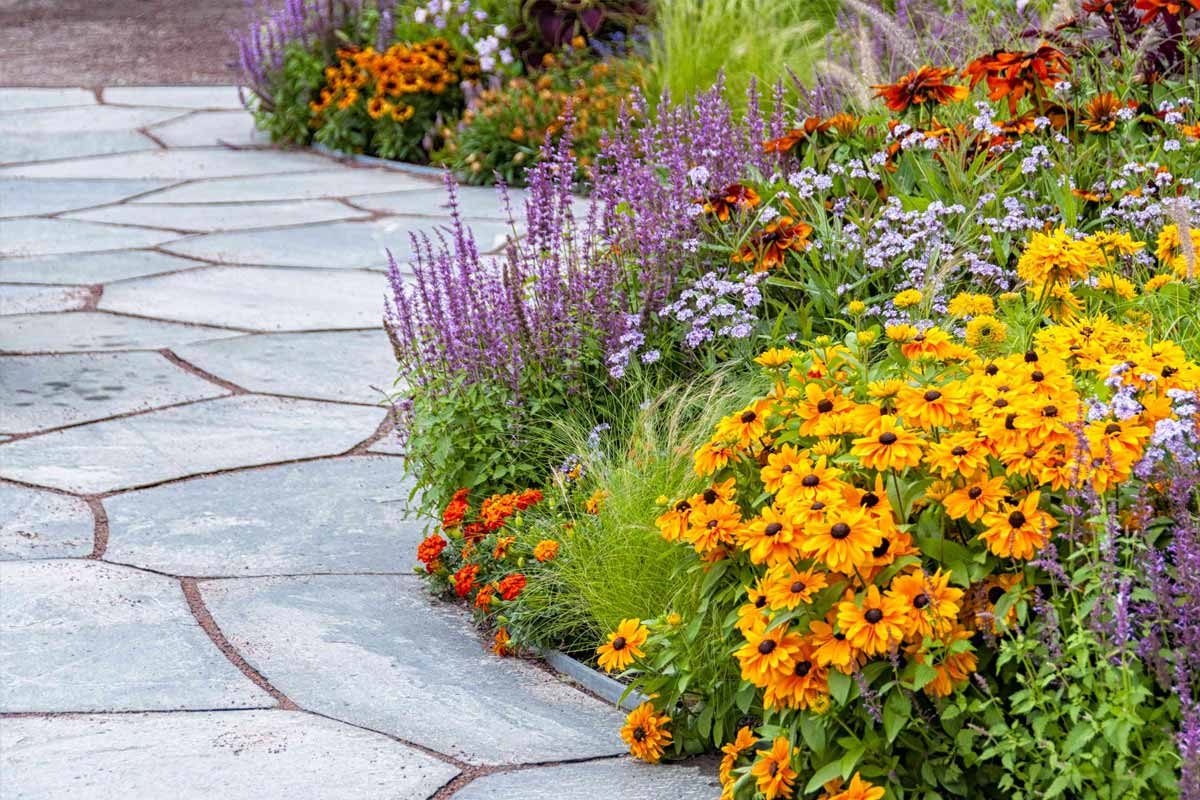Plant once, enjoy again: fall rewards gardeners who think ahead. Choose Perennial Plants that root fast, shrug off cold, and wake strong each spring. With the right eight, beds glow for months, paths stay lively, and costs drop because replanting ends. Sun, shade, and soil all have matches here, so planning feels easy. Start now, set each crown well, and let next year’s color take care of itself. Your garden rests this winter, then returns bold, steady, and low-maintenance.
Black-Eyed Susan : sunlit cheer that lasts
Bright petals and a bold eye make Black-Eyed Susan a beacon that keeps beds cheerful. Because Perennial Plants reduce replanting, this heat-loving workhorse shines through hot spells and dry snaps. Steady blooms fill borders, while seed heads feed birds and nectar draws bees.
- Name: Black-Eyed Susan (Rudbeckia hirta).
- USDA Hardiness Zones: 3–11.
- Light: full sun.
- Soil: well-drained, so roots stay healthy.
Heat and drought tolerance stays high, so borders keep flowering. Plant in groups, because clumps create bright drifts and tidy, low-care garden structure.
Chrysanthemum : autumn color that returns
Chrysanthemums deliver a final burst when gardens fade, because fall beds need fresh color and shape. These Perennial Plants form bushy mounds with button, daisy, or spider blooms in palettes. They handle early frosts well, so borders glow while annuals fade and containers stay polished.
- Name: Chrysanthemum.
- USDA Hardiness Zones: 5–9.
- Light: full sun or part shade, because strong light keeps stems sturdy.
- Soil: well-drained and moist, so roots stay cool.
Plants return several years; after a few seasons, vigor wanes, so replace clumps to keep color dependable.
Daylily : sun-hardy color on repeat
Daylilies deliver color like clockwork, because each scape sends bud after bud in warm weather. These Perennial Plants love full sun and handle dry spells, so maintenance stays light. They still bloom in shade, and breeders offer reblooming strains or single-flush types for impact.
- Name: Daylily (Hemerocallis).
- USDA Hardiness Zones: 3–10.
- Light: full sun for best blooms; some flowers in part shade.
- Soil: well-drained.
Drought resistance stays high, so watering stays simple. Choose reblooming strains for steady color, or pick one-time performers for a stunning wave.
Hosta : shade-rich texture and flowers
Hostas turn bare shade into layered texture, because wide leaves overlap and calm designs. These Perennial Plants excel in containers and beds, so tricky corners finally look finished. Variegated and blue forms add depth, while summer stalks carry pale flowers that draw hummingbirds and bees.
- Name: Hosta (Hosta plantaginea).
- USDA Hardiness Zones: 3–9.
- Light: shady to full sun; best leaf color forms in shade.
- Soil: consistently moist, so foliage stays lush.
Plants thrive in the ground or pots, and they offer fast ground cover where sun-loving flowers fail.
Peony : fragrant, long-lived showstoppers
Peonies bring oversized blooms with soft scent, because woody crowns store years of energy. These Perennial Plants reward patience; plant once, then enjoy cut-flower stems that last. Bud-heavy plants open in waves, so borders look generous, and ants on buds are harmless companions.
- Name: Peony (Paeonia lactiflora).
- USDA Hardiness Zones: 3–8.
- Light: part shade to full sun; afternoon shade protects blooms.
- Soil: well-drained.
Long-living and low-maintenance, plants form clumps that return for decades. One planting reliably yields many fragrant stems again each late springtime.
Perennial sage: spires, pollinators, and easy care
Perennial sage adds vertical rhythm and a clean scent, because spires rise above tidy mounds in late spring. These Perennial Plants feed bees and butterflies while filling gaps between shrubs and roses. Purple, white, and blue spikes read clearly from distance, so borders gain structure.
- Name: Hybrid perennial sage (Salvia × sylvestris).
- USDA Hardiness Zones: 4–9.
- Light: full sun.
- Soil: well-drained.
Tall late-spring spikes bring weeks of color with simple care. Deadheading extends bloom and keeps mounds neat, tidy, compact, and very pleasantly fragrant without any extra fuss.
Siberian iris : height, moisture tolerance, and early color
Siberian iris lifts beds with slim blades and elegant blooms, because vertical lines make gardens look deeper. These Perennial Plants suit wetter climates and handle spring moisture, so rain-soaked spots earn flowers. Early summer blossoms in blue, purple, and white cut for bouquets well.
- Name: Siberian Iris (Iris sibirica).
- USDA Hardiness Zones: 3–9.
- Light: full sun.
- Soil: well-drained, moist.
Grass-like foliage stays upright after bloom, so clumps look neat. Tall stems add height early in summer, and the multicolored flowers suit cutting for long-lasting vases.
Veronica : long-season spikes for many climates
Veronica carries color all season, because spires keep opening from early summer into fall. These Perennial Plants adapt across regions; in cool northern zones they thrive in sun, while southern sites welcome shade. Slender wands add motion and texture, so paths and edges feel lively.
- Name: Veronica (Veronica officinalis).
- USDA Hardiness Zones: 3–11.
- Light: full sun in the north; part shade in hotter south.
- Soil: well-drained, can tolerate dry.
Bloom runs from early summer into fall, and spires reach 7 inches, so borders carry bold color for months.
Plant once this fall and enjoy effortless regrowth next spring
Choose boldly and prepare beds now, because the right Perennial Plants deliver beauty and savings for years. Match sun and shade carefully, keep soil well-drained, then water in and mulch, so crowns stay protected. Stake tall stems early if winds rise, and add compost each spring, so vigor builds. When blooms decline, divide crowded clumps. Replace tired plants after several seasons, so color, fragrance, and structure return predictably after winter.
